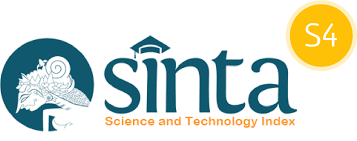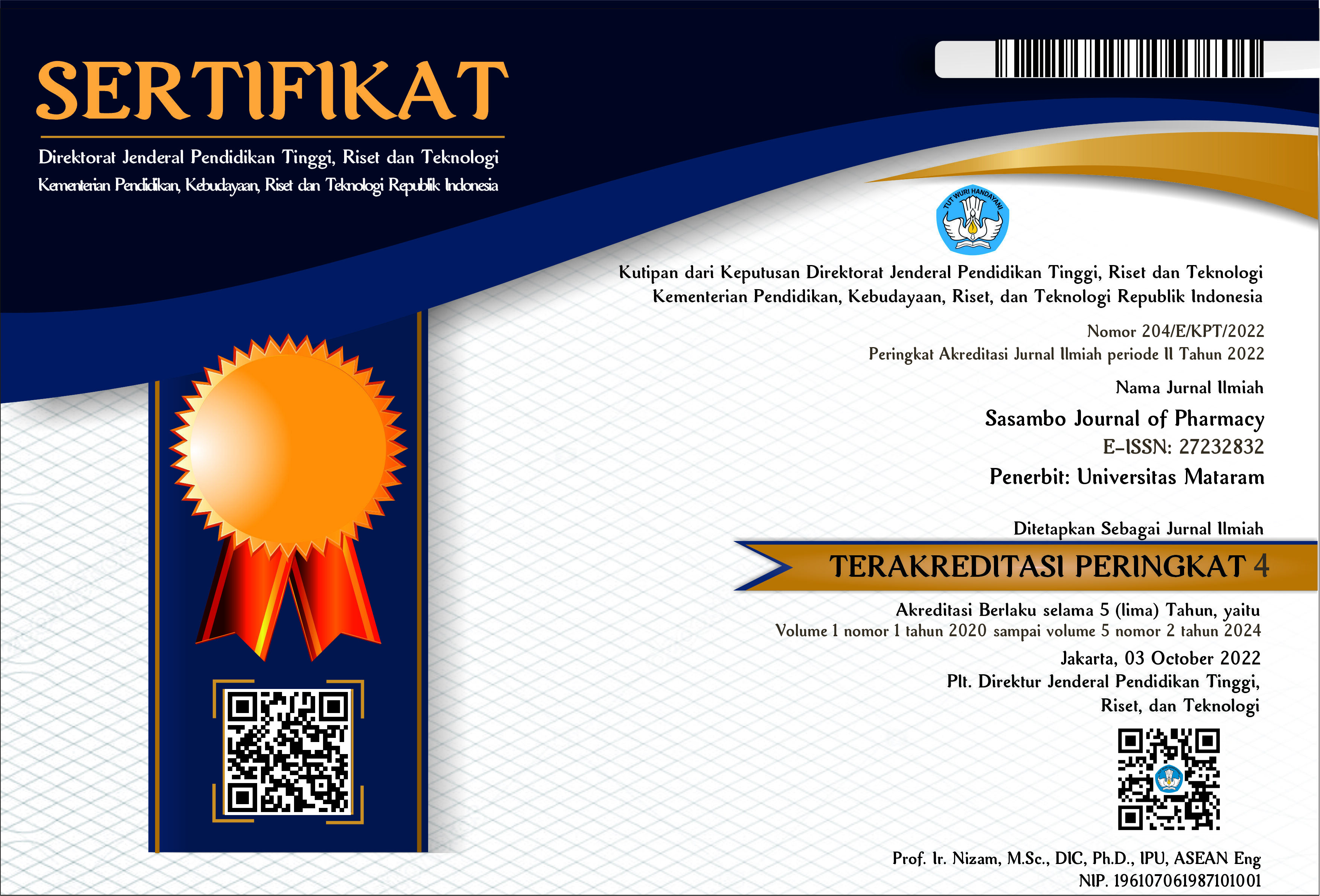Physical characterization of paracetamol granule preparation using goroho banana starch as binder and disintegrant
Penulis
Mutmainnah Mutmainnah , Abulkhair Abdullah , Sandra Lewa , S. Masitah MuhlisDOI:
10.29303/sjp.v6i1.393Diterbitkan:
2025-04-30Terbitan:
Vol 6 No 1 (2025): AprilKata Kunci:
binder, disintegrant, goroho banana, paracetamol granules, starchArticles
##submission.downloads##
Cara Mengutip
Abstrak
The research aims to formulate Goroho banana starch (GBS) as a binding and disintegrating agent in paracetamol (PCT) granule preparations. PCT granules were made using GBS as a binding agent in 3 concentrations of 6, 8, and 10%, respectively. PCT granules using GBS as a disintegrating agent were made with three concentrations of 10, 15, and 20%, respectively. Paracetamol granules are made using the wet granulation method. Granules were evaluated using six parameters: flow rate, angle of repose, water content, bulk density, tapped density, and compressibility index. GBS as a binder showed good physical properties. F1 (6% GBS) showed a flow rate of 8.1 g/sec, an angle of repose of 22.9 degrees, a water content of 1.2%, and a compressibility index of 19.3%. F2 (8% GBS) shows a flow rate of 8.5 g/sec, an angle of repose of 18.5 degrees, a water content of 1.3%, and a compressibility index of 17.6%. F3 (10% GBS) shows a flow rate of 9.0 g/sec, an angle of repose of 21.5 degrees, a water content of 1.4%, and a compressibility index of 19.3%. 8% GBS showed the best physical properties as a binding agent for PCT granules. GBS as a disintegrating agent, shows excellent physical properties. F4 (10% GBS) shows a flow rate of 12.9 g/sec, an angle of repose of 17.0 degrees, a water content of 4.3%, and a compressibility index of 13.3%. F5 (15% GBS) shows a flow rate of 11.4 g/sec, an angle of repose of 18.0 degrees, a water content of 1.4%, and a compressibility index of 14.5%. F6 (20% GBS) shows a flow rate of 10.7 g/sec, an angle of repose of 23.0 degrees, a water content of 3.5%, and a compressibility index of 14.6%. 10% GBS showed the best physical properties as a disintegrants agent for PCT granules.Referensi
Cheiya, I. V., Rusli, R., & Fitriani, N. (2023). Pemanfaatan Limbah Pati Kulit Pisang (Musa paradisiaca) sebagai Bahan Pengikat Granul Parasetamol dengan Metode Granulasi Basah. Jurnal Sains Dan Kesehatan, 5(1), 44–49. https://doi.org/10.25026/jsk.v5i1.1606
Dürig, T., & Karan, K. (2019). Binders in Wet Granulation. In Handbook of Pharmaceutical Wet Granulation: Theory and Practice in a Quality by Design Paradigm (pp. 317–349). Academic Press. https://doi.org/10.1016/B978-0-12-810460-6.00010-5
Edy, H. J., & Mansauda, K. L. R. (2020). Teknologi dan Formulasi Sediaan Padat. Penerbit Lakeisha.
Elisabeth, V., Yamlean, P. V. Y., & Supriati, H. S. (2018). Formulasi Sediaan Granul dengan Bahan pengikat Pati Kulit Pisang Goroho (Musa acuminafe L.) dan Pengaruhnya pada Sifat Fisik Granul. Pharmacon: Jurnal Ilmiah Farmasi, 7(4), 1–11.
Harni, M., Anggraini, T., Rini, & Suliansyah, I. (2022). Review Artikel: Pati pada Berbagai Sumber Tanaman. Agroteknika, 5(1), 26–39. https://doi.org/10.55043/agroteknika.v5i1.118
Kunle, O. O. (2020). Starch Source and Its Impact on Pharmaceutical Applications. In Chemical Properties of Starch. IntechOpen. https://doi.org/10.5772/intechopen.89811
Marta, H., Cahyana, Y., Djali, M., & Pramafisi, G. (2022). The Properties, Modification, and Application of Banana Starch. Polymers, 14(3092). https://doi.org/10.3390/polym14153092
Mirhosseini, H., & Amid, B. T. (2013). Effect of Different Drying Techniques on Flowability Characteristics and Chemical Properties of Natural Carbohydrate-Protein Gum from Durian Fruit Seed. Chemistry Central Journal, 7(1), 1–14. https://doi.org/10.1186/1752-153X-7-1
Mojiono, & Sholehah, D. N. (2020). Optimasi Ekstraksi Pati Jagung Madura-3 Berdasarkan Lama Perendaman dan Konsentrasi NaOH. Rekayasa, 13(2), 118–124. https://doi.org/10.21107/rekayasa.v13i2.6429
Ningsi, P. (2017). Studi Potensi Pati Umbi Ubi Kelapa (Dioscorea alata L.) sebagai Bahan Penghancur Tablet. UIN Alauddin Makassar.
Özalp, Y., Chunu, J. T., & Jiwa, N. (2020). Investigation of the Compressibility Characteristics of Paracetamol using “Compaction Simulator.” Turkish Journal of Pharmaceutical Sciences, 17(3), 249–253. https://doi.org/10.4274/tjps.galenos.2019.38278
Parumpa, N. H. D., Kasim, R., Liputo, S. A., Bait, Y., Mahaling, E. M., Mokodompit, F., Usman, R. R., & Nur, Y. (2023). Karakteristik Bubur Instan Kombinasi Pisang Goroho dan Kacang Merah. Prosiding Seminar Nasional Mini Riset Mahasiswa, 2(2), 141–151.
Patel, S. G., & Siddaiah, M. (2018). Formulation and evaluation of effervescent tablets: a review. Journal of Drug Delivery and Therapeutics, 8(6), 296–303. https://doi.org/10.22270/jddt.v8i6.2021
P
ires, M. B., Amante, E. R., Petkowicz, C. L. de O., Esmerino, E. A., Rodrigues, A. M. da C., & Silva, L. H. M. da. (2021). Impact of Extraction Methods and Genotypes on The Properties of Starch from Peach Palm (Bactris gasipaes Kunth)
Fruits. LWT - Food Science and Technology, 150, 111983. https://doi.org/10.1016/j.lwt.2021.111983
Prajapati, B. G., & Mishra, O. (2021). Concept, Manufacturing, and Characterization of Effervescent Tablets: A Review. SunText Review of Pharmaceutical Sciences, 2(1). https://doi.org/10.51737/2766-5232.2021.010
Putra, I. G. N. A. D., Murwanti, R., Rohman, A., & Sulaiman, T. N. S. (2018). Physical and Chemical Properties of Native and Fully Pregelatinized Cassava Starch (Manihot esculenta Crantz). Indonesian Journal of Pharmacy, 29(3), 145–156. https://doi.org/10.14499/indonesianjpharm29iss3pp145
Putra, O. N., Auli, W. N., Musa, Paramitasari, D., & Mawarni, G. K. (2022). The Effect of Partially Pregelatinized Cassava Starch as Disintegrant for Paracetamol Tablet. Pharmaciana, 12(3), 335–345. https://doi.org/10.12928/pharmaciana.v12i3.24343
Rowe, R. C., Sheskey, P. J., & Quinn, M. E. (2009). Handbook of Pharmaceutical Excipient 6th Edition. Pharmaceutical Press.
Saryanti, D., Ismawati, H., & Setiawan, I. (2019). Optimasi Campuran Pati Jagung dan Avicel PH 101 sebagai Bahan Penghancur pada Tablet Ekstrak Buah Pare (Momordica charantia L.) secara Granulasi Basah. Jurnal Ilmiah Manuntung, 5(1), 106–114.
Sharma, S., Sharma, T., Deep, M., & Sharma, A. (2021). Techniques to Determine Powder Flow Properties. CGC International Journal of Contemporary Technology and Research, 3(2), 1–6. https://doi.org/10.46860/cgcijctr.2021.06.31.199
Suarni, I. U., Firmansyah, & Aqil, M. (2013). Keragaman Mutu Pati Beberapa Varietas Jagung. Penelitian Pertanian Tanaman Pangan, 32(1), 50–56.
Sugiyono, Komariyatun, S., & Hidayati, D. N. (2017). Formulasi Tablet Parasetamol Menggunakan Tepung Bonggol Pisang Kepok (Musa paradisiaca cv. Kepok) sebagai Bahan Pengikat. Media Farmasi Indonesia, 12(1), 1156–1166.
Sulaiman, T. N. S., Wahyono, Bestari, A. N., & Aziza, F. N. (2022). Preparation and Characterization of Pregelatinized Sago Starch (PSS) from Native Sago Starch and Its Evaluation as Tablet Disintegrant and Filler-Binder on Direct Compression Tablet. Indonesian Journal of Pharmacy, 32(2), 251–260. https://doi.org/10.22146/ijp.3543
Suniati, F. R. T., & Purnomo, H. (2019). Goroho (Musa acuminafe, sp) Banana Flour as Natural Antioxidant Source in Indonesian Meatball Production. Food Research, 3(6), 678–683. https://doi.org/10.26656/fr.2017.3(6).302
Taringan, A. M., Nurali, E. J. N., & Taroreh, M. (2019). Pengaruh Substitusi Pisang Goroho dan Kacang Merah terhadap Kualitas Fisik, Kimia, dan Sensoris Flakes Ubi Jalar Kkuning (Ipomoea batatas L.) sebagai Makanan Bebas Gluten Bebas Kasein. Jurnal Teknologi Pertanian, 10(2).
Tripathee, B., Hussain, K., & Prajapati, R. (2023). Review on Excipients Used in Immediate Release Tablets Formulation. International Journal of Novel Research and Development, 8(7), 39–53.
Vikas, G., Mahesh, B., Nilam, D., & Yogita, T. (2018). Development and Evaluation of Polyhebral Powder Formulation as Energy Booster. Journal of Pharmacognosy and Phytochemistry, 7(3), 1576–1580.
Wahyuni. (2016). Pemanfaatan Pati Umbi Tire (Amorphophallus onchopillus) sebagai Bahan Pengikat Tablet Parasetamol dengan Metode Granulasi Basah. UIN Alauddin Makassar.
Lisensi
Hak Cipta (c) 2025 The Author(s)

Artikel ini berlisensi Creative Commons Attribution 4.0 International License.
Authors who publish with Sasambo Journal of Pharmacy (SJP), agree to the following terms:
- Authors retain copyright and grant the journal right of first publication with the work simultaneously licensed under a Lisensi Creative Commons Atribusi 4.0 Internasional. This license allows authors to use all articles, data sets, graphics and appendices in data mining applications, search engines, web sites, blogs, and other platforms by providing an appropriate reference. The journal allows the author(s) to hold the copyright without restrictions and will retain publishing rights without restrictions.
- Authors are able to enter into separate, additional contractual arrangements for the non-exclusive distribution of the journal's published version of the work (e.g., post it to an institutional repository or publish it in a book), with an acknowledgment of its initial publication in Sasambo Journal of Pharmacy
- Authors are permitted and encouraged to post their work online (e.g., in institutional repositories or on their website) prior to and during the submission process, as it can lead to productive exchanges, as well as earlier and greater citation of published work (See The Effect of Open Access).





















